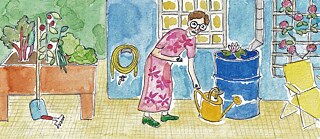Rainy days are becoming less frequent and June was really hot. Granny Trude’s been thinking about her water consumption – both direct and indirect. One thing’s clear – we could all be kinder to the water cycle and the environment. Granny Trude has some useful tips.
My dears,It’s summer at last! You’ve all known for a long time that it’s my absolute favourite season! And that’s not just since Strada del Sole by Reinhard Fendrich. I love that song! It lifts my spirits particularly at the moment, since the corona pandemic has put a stop to my globetrotting. But making a fuss isn’t my style, I’m fine, and I’m seeing my family regularly again too.
Only the best for my plants
Because it was the hottest June since records began in Germany, I’ve been thinking about my water consumption, the water my plants use, and my energy consumption. I’ve always watered my beloved greenery with rainwater because it’s much better for them. Lately I’ve even put up a second water butt to catch the rain. After all there are considerably fewer wet days, so we don’t want that precious moisture to be wasted. Incidentally, that’s something you can even try on your balcony – with smaller receptacles. Your plants will love it!Save and maintain water quality
They always used to say “Save water”. I thought that was because we had to live thriftily as a general rule. Today I know there’s more to it than that! Of course water costs money, and the less you consume, the lower your bill. But as my granddaughter Viola so neatly puts it: “Granny, it’s only peanuts.” In the case of water she’s right, it’s not as expensive as you might think. For a cent you get five litres. And since we Germans use an average of 123 litres of water every day, it costs us about 25 cents a day, which is in the region of 90 euros per person per year.By the way, it’s more important to be careful about warm water than cold water. It saves energy, reduces greenhouse gas emissions and is easier on the household budget. I’ve read that the household water consumption has dropped by 20 to 25 litres per day for Germans over the past 30 years. Well, that’s a very successful start. But it’s not enough to maintain the vital water cycle. The thing is, unfortunately our domestic and industrial waste water is sometimes highly contaminated when it returns to the cycle. And the more contaminated water is, the more energy you need to turn it back into pure drinking water. So we should make sure we’re sensible with water, and be careful what we tip down the drain. That’s certainly a more sustainable approach than saving a litre here and there.
Things you won’t find in my drain
Things we shouldn’t put down the drain at all, or only in small quantities, because they pollute the waste water to such an extent:Toilet rim blocks and cistern additives
No one needs these! I’ve never had anything like this in my home, and I’ve managed perfectly well without.
Toilet cleaner
I’ve got a tip for you, search for homemade toilet cleaner on the internet, using those exact keywords. You do have to take a bit of time if you want to make a cleaner with gel consistency, but after all our planet and environment deserve that!
Drain cleaner
My grandson Michi says he always manages to clear a plughole blocked with hairs with a few bottles of cola. It’s meant to be less damaging than the aggressive drain cleaners.
Paint, varnish, solvents and medication
Plain as day – you don’t put any of these down the drain.
A dangerously high water footprint
Did you know that every single one of us can take a share of the blame for the water consumed during the manufacture of products we use on a daily basis? We call this “virtual water”. And what we know about consumption statistics really makes me feel sad. They say I use 4000 litres of water a day indirectly? For Heaven’s sake, how can that be true? If I buy a kilo of bananas for my grandson, I’m using 860 litres of water indirectly! If I buy a kilo of cheese, my consumption hits 10 000 litres of water – which includes the cow producing the milk in the equation. That is rather shocking!Numbers are even higher in the consumer goods sector than for food. By the time they’ve finished making a car, 400 000 litres of water have been used. A pair of jeans accounts for 11000 litres, and a cotton T-shirt 2 400 litres of water. Since I found that out, I've decided something: not to buy so many clothes, or to shop in second-hand stores more often – and to take part in clothes swaps. Luckily that’s right on trend!
One thing I like is that regional food creates a smaller water footprint. A kilo of potatoes from Georg, the farmer next door, has consumed 120 litres of water on average – and most of it came from the rain. Of course my motto’s always been “regional and seasonal”. And if we buy organic foods it’s gentler on the groundwater. You see, fertiliser, even natural slurry, and pesticides pollute it heavily.
Have I got you thinking a bit? That was indeed my intention – so make sure you do something about it!
Have a lovely summer, and stay healthy!
Yours, Trude
August 2020
